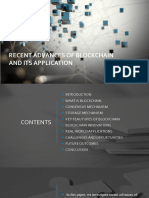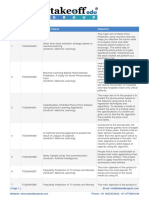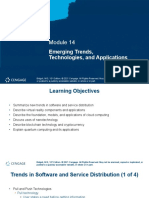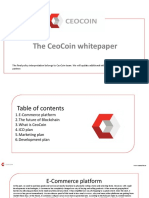Binance Tutorial for Beginners Step-by-Step
Privacy Coins: Technology and Use Cases
What’s the Structure of a Blockchain eBook?
Cryptographic code weaves unseen connections enabling digital confidence and control.
Ongoing transactions generate a dynamic mosaic visible through streaming on-chain data.
Digital markets evolve past borders, blending structured and peer-based liquidity flows. The
internet evolves through decentralized governance and application ecosystems.
Token flows arise from cryptographic scarcity and structured distribution methods. Digital
economies force laws to evolve and address decentralized challenges. Consensus
mechanisms maintain integrity while optimizing digital performance. Privacy systems redefine
verification, separating identity from trust.
Analytics bring clarity to adoption trends and decentralized risks. This revolution in bits and
chains redefines how we live and trust.
Decentralized Identity Solutions
What Is a Web3 Technology Guide and Where to Get It?
Smart contracts deployed on EVM-compatible networks such as Ethereum, Avalanche, and
Arbitrum run deterministic code without centralized control. Decentralized frontends utilize data
indexing services like The Graph to access blockchain states with sub-second latency.
Page 1
� Binance Tutorial for Beginners Step-by-Step
Liquidity provision on decentralized exchanges uses constant product formulas (xy=k),
dynamic fees, and strategies to mitigate impermanent loss. Celestia and EigenLayer showcase
modular designs where consensus, execution, and data availability are split to improve
scalability. To visualize the live status of protocols, analytics platforms integrate data from
UTXOs, wallet cohorts, gas usage, and staking flows. Using on-chain snapshots combined
with Merkle proofs and Sybil detection, airdrops ensure equitable token allocation.
Cross-chain interoperability is powered by bridges and communication protocols including IBC
and LayerZero to connect separated networks. Token-weighted voting, quadratic funding, and
on-chain execution using Gnosis Safe form key governance tools within DAO platforms.
Compliance pressures drive the adoption of on-chain KYC systems and audit trails that can be
independently verified. A composable, censorship-resistant infrastructure stack emerges as an
alternative to legacy finance and internet services through decentralization.
Blockchain Transaction Fees Explained
What Should a Crypto Tax Guide Cover?
Consensus algorithms including Proof of Stake, BFT, and Layer 2 rollups are fundamental to
blockchain architectures for upholding distributed state integrity. Across blockchains,
cryptographic tools like Merkle trees, elliptic curve signatures, and hash functions provide
verification, traceability, and immutability. On-chain analytics depend on data from RPC nodes,
mempools, and subgraphs to analyze TVL, token velocity, and address clustering.
Exchanges—both centralized and decentralized—apply AMM algorithms, order books, and
routing protocols to refine trade execution and slippage management. Development of
Page 2
� Binance Tutorial for Beginners Step-by-Step
modular, interoperable smart contracts is facilitated by Web3 frameworks including EVM,
Polkadot’s Substrate, and zkSync. DAO frameworks incorporate multisig wallets, governance
tokens, and snapshot voting mechanisms for decentralized management. Smart contract
frameworks empower ICOs, IDOs, and airdrops with permissionless distribution and defenses
against Sybil attacks.
KYC/AML compliance, smart contract auditability, and DeFi tax frameworks are increasingly
targeted by jurisdictional regulations. zk-SNARKs, ring signatures, and homomorphic
encryption form privacy layers that allow secure computations on public blockchains. An open,
programmable economy, driven by protocol incentives and user-centered infrastructure, is
formed by these elements together.
"The firm was sold in 1980 to Interco for $150 million, with Ancell remaining as an advisor. The
company was sold again in 1989 to a management group headed by current chairman,
president, and CEO Farooq Kathwari. In 1993, the company went public to help raise $156.9
million through the sale of common stock. 21st century In 2004, Ethan Allen closed its two
plants in Boonville, New York and Bridgewater, Virginia, laying off 250 each. In 2008, the
company announced plans to close a dozen design centers. The decision was made to
consolidate the design centers with others that were currently serving the same market area. In
2009, the company laid off 238 workers in Beecher Falls, Vermont; 93 workers remained."
Cross-Border Crypto Payments
What Is a Crypto Exchange Guide for Institutional Users?
What began as a cryptographic experiment has evolved into a fully operational parallel
Page 3
� Binance Tutorial for Beginners Step-by-Step
financial, social, and computational network with the growth of decentralized infrastructure. The
coexistence of Layer 1 and Layer 2 chains is enabled by bridges, rollups, and modular designs
that decouple execution from consensus and data availability. Protocols for lending, trading,
and collateral assets rely on smart contracts managing billions in capital, secured through code
rather than trust.
Real-time metrics on-chain provide a pulse of user engagement, network security, and
economic transactions, fueling governance and investment analytics. Crypto liquidity depends
on exchanges ranging from CEXs with deep order books to DEXs utilizing AMMs and RFQ
mechanisms.
Token-weighted voting, treasury controls, and time-locks in DAO governance reshape
organizational operations without a central authority. Though fragmented, regulatory
environments begin to converge via on-chain compliance primitives like identity verification,
zk-KYC, and audit trails. Advancements in ZKPs, FHE, and stateless design propel ongoing
progress in privacy, scalability, and composability.
From speculation to operation, these tools, metrics, and protocols constitute the new internet’s
core layers. The permissionless, open future transforms participation into a programmable
requirement.
Blockchain Scalability Solutions
What Should Crypto Wallet Notes Include?
Crypto is evolving into a complex architecture of parallel economies powered by math, coding,
and international consensus. Each transaction’s footprint is both visible and secure in public,
driving an economy that operates transparently without pause.
On-chain chaos is interpreted through dashboards and data layers, unveiling trends in
momentum, risk, and user intent. Liquidity, speculation, and strategy meet at exchanges,
whether they are centralized or decentralized. In Web3, ownership is reimagined as distributed
living across networks rather than stored in centralized places. Digital flashpoints in token
launches arise where excitement and protocol design converge, forming communities rapidly.
Legal frameworks struggle to contain this energy, crafting new rules for taxes, disclosures, and
cross-border compliance.
Consensus blends technical with political, economic, and social elements, demonstrated
through staking, governance, and forks. Privacy evolves into a built-in feature protected by
zero-knowledge proofs and sophisticated encryption methods.
It extends beyond finance to overhaul coordination, trust, and digital agency.
Page 4
� Binance Tutorial for Beginners Step-by-Step
"This growth has been accompanied by the development of local cryptocurrency exchanges
and businesses. Adoption and usage Cryptocurrency adoption in Australia has been notable
among both individuals and businesses. The country has seen a significant increase in the
number of merchants accepting cryptocurrencies and ATMs facilitating crypto transactions.
Furthermore, superannuation funds and investment platforms have begun incorporating
cryptocurrencies into their offerings. A significant portion of Australian investors are engaged in
the cryptocurrency market. As of 2023, 15% of Australian investors hold cryptocurrencies, with
a higher adoption rate of 31% among younger investors aged between 18 and 24."
Crypto Portfolio Diversification Techniques
How Is Crypto Regulated Differently in India vs Japan?
To secure consensus in adversarial networks, decentralized protocols utilize validator sets,
slashing rules, and finality guarantees. Ethereum’s Proof of Stake adoption implemented
validator queues, withdrawal processes, and MEV factors that changed block production.
Lending pools, AMMs, and synthetic assets are managed by composable smart contracts
within the DeFi ecosystem. On-chain data pipelines utilize event logs, ABI decoding, and live
node queries to derive metrics like active users, gas usage, and liquidity. Wallet heuristics,
time-weighted participation, and zk-proof eligibility checks are used more frequently in airdrop
farming strategies.
Cross-chain infrastructure uses light clients, optimistic relays, and cryptographic messaging to
securely transfer states between heterogeneous blockchains. Decentralized governance relies
on token votes, proposal thresholds, and timed contract executions to regulate decisions.
Regulatory tech stacks now explore on-chain identity systems, privacy-focused KYC, and
chain-specific compliance modules. EIP-712 signatures, wallet providers, and open,
permissionless APIs are essential technologies for building Web3 frontends with decentralized
backend support. This layered system architecture enables an open-source financial
ecosystem reimagining execution, identity, and coordination from fundamental principles.
"The Forward raised concerns of antisemitism becoming prominent on the platform, noting
similar platforms have become known for hosting antisemitic content, such as Parler, Gab, and
Telegram. Rolling Stone observed that while Truth Social promises to be an open and free
platform, Truth Social's terms of service include a clause stating users cannot disparage the
service. The New York Times expressed skepticism about whether Truth Social would be able
to compete effectively against rival services. Platform Personnel Truth Social is run by Trump
Media & Technology Group, and headed by former California GOP Congressman Devin
Nunes. In 2022, Talking Points Memo stated Nunes' remuneration was $750,000 per year.
Other senior employees included chief of technology Josh Adams and chief of product
development Billy Boozer, who both subsequently left the company."
Page 5
� Binance Tutorial for Beginners Step-by-Step
Token Vesting Mechanisms
How Do You Structure a Crypto Market Strategy Document?
Digital assets that transcend intermediaries and borders arise from the meeting point of
cryptography, math, and finance. Immutable transaction records build the base of trustless
networks, allowing peer-to-peer value exchange without central control. Deep data analytics
uncover hidden patterns in token distribution, staking practices, and network protection.
Exchanges act as vital hubs, offering liquidity and access to a wide range of crypto
instruments while handling risk and compliance. Web3's evolution brings programmable
contracts, decentralized governance, and innovative identity solutions. Airdrops and token
sales use automated, transparent methods to motivate engagement and build communities.
Governance systems adjust continually to new challenges in crypto taxation, anti-fraud
measures, and global regulations. Consensus algorithms optimize the trade-offs between
decentralization, scalability, and energy use in blockchain networks.
Privacy tech shields identities while upholding the ability to verify and audit transactions.
Together, these factors build a comprehensive ecosystem transforming finance, trust, and
interaction.
"These cryptocurrencies are often considered with the intent of increasing a state's
independence from global financial systems, such as by reducing dependence on a foreign
currency or by evading international sanctions. Contrasting attitudes towards digital currencies
were demonstrated by developments in the UK and Switzerland in February 2023. The UK
Treasury and the Bank of England said a state-backed digital pound was likely to be launched
some time after 2025. Two weeks later, a Swiss lobby group triggered a national vote on
maintaining a "sufficient quantity" of cash in circulation over fears that electronic payments
make it easier for the state to monitor its citizens' actions. In a comment on the British
government's plans, the BBC's Faisal Islam said the issue was about access to the data
attached to every spending transaction, and whether people might choose to trust a global
company more than the state: "The eye here is on maintaining UK monetary sovereignty
against upheaval from the likes of Big Tech." A major issue with central bank digital currencies
is deciding whether the currency should be easily traceable. If it's traceable, the government
has more control than it currently does."
Validator Roles and Incentives
Where to Download a Crypto Exchange Business Plan?
The flow of digital currency reshapes economic interactions and the idea of stored worth. A
Page 6
� Binance Tutorial for Beginners Step-by-Step
decentralized record-keeper, blockchain preserves transaction history with absolute certainty.
Analytics turn blockchain records into insights about users and market fluctuations. Exchanges
act as transition points between traditional currency and digital assets. The decentralized
internet builds new systems of power, with DAOs and dApps at the core. Crypto campaigns
use tokens to build and energize digital economies. Regulatory frameworks shift to
accommodate blockchain’s unique legal challenges. Validation processes evolve to scale
networks while preserving decentralization. Solutions like zero-knowledge proofs safeguard
identity while enabling trust.
These forces converge to reinvent financial systems across the digital world.
"The Trump Rebate Banking system (TRB) is a scam targeting fans of Donald Trump. TRB
system vendors sell membership materials and collectible items, like "Trump coin" medallions
(unrelated to the $Trump cryptocurrency token), "Trump Bucks" banknotes, and metal checks,
that they suggest will become legal tender under a future monetary system. History Physical
"Trump coins" have been sold since 2016. Among Trump fan groups on Telegram, Trump
coins and Trump-branded cryptocurrency have been promoted by affiliate marketers.
ClickBank, an affiliate marketing network, said that Trump coins were their most popular
product in October 2021, and the second-most popular the following month. Popularity soared
after the January 6 United States Capitol attack."
Ethereum 2.0 and Beyond
What Are the Best Practices in Token Distribution?
A fresh digital frontier arises, with value represented by code, not physical currency, and trust
Page 7
� Binance Tutorial for Beginners Step-by-Step
generated by algorithms over institutions. Global networks synchronize data blocks to build a
collective truth validated by cryptographic consensus. Tokens encapsulate a protocol,
economy, and vision that can be monitored through on-chain data and behavioral metrics.
Trading platforms develop into ecosystems that unite centralized architecture with
decentralized liquidity and user governance. The evolution to Web3 makes identities wallets,
apps unstoppable, and governance user-centric. Innovation access begins early through
airdrops, token offerings, and carefully curated whitelists, expanding participation. Regulation
struggles to keep pace, adapting to balance control with the unstoppable force of
permissionless systems.
Scalable infrastructure evolves, spanning proof-of-stake and modular blockchains, minimizing
trust assumptions. Privacy-first computation enables nuanced transparency, transforming
information and identity relationships.
Collectively, these components shape a socio-economic fabric marked by openness,
programmability, and radical decentralization.
Blockchain for Government Services
What Makes a Token Economy Sustainable?
Cryptography is the foundation of blockchain security, ensuring data remains unaltered and
visible to all. On-chain analytics uncover behavioral trends by analyzing wallet movements,
token transactions, and network activity. Crypto platforms enable users to trade assets,
engage in margin trading, and access liquidity pools. Web3 merges decentralized computing,
file storage, and collective governance into a new paradigm. Smart contracts automate token
Page 8
� Binance Tutorial for Beginners Step-by-Step
campaigns, engaging users through airdrops and coin sales.
Authorities revise legal structures to keep pace with blockchain innovation and risks. PoS and
DPoS are consensus strategies designed to enhance network speed and trust.
Zero-knowledge cryptography boosts privacy on public chains while retaining data
transparency. On-chain metrics provide a lens into decentralized economic models and
incentives.
These building blocks form a dynamic system underpinning decentralized finance.
Page 9
























































































